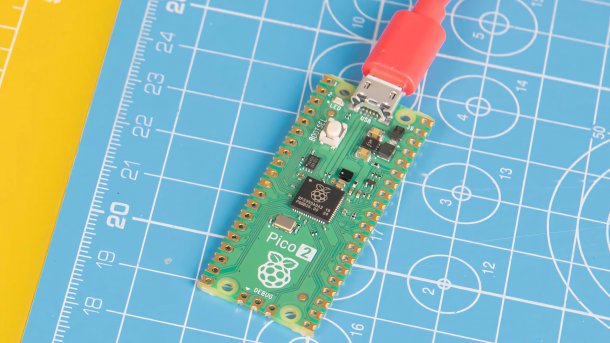Raspberry Pi Pico 2 with RP2350 microcontroller: powerful ARM cores and RISC-V
Surprise from the Raspi developers: The RP2350 chip of the Pico 2 is not only more powerful than the RP2040, but also has alternatively usable RISC-V cores.

Raspberry Pi Pico 2: Microcontroller board with RP2350, which has ARM and RISC-V cores.
(Image: Raspberry Pi Plc.)
The Raspberry Pi developers present the Pico 2 microcontroller board with the RP2350 chip they developed themselves. Not only does it have two more powerful ARM cores than the RP2040 introduced with the Pico three years ago, more SRAM and more functions. It also contains two RISC-V cores called "Hazard3" developed by the Raspi team itself. These can be used as an alternative to the ARM cores.
Raspberry Pi Plc. had already announced the development of an "RP235x" in its IPO prospectus in June. However, there was no mention of RISC-V cores at the time. The RISC-V development is also surprising because the British CPU development company ARM holds around 3.5 percent of the shares in Raspberry Pi Plc. Both companies are based in Cambridge, UK.
Videos by heise
RP2350 in detail
While the RP2040 presented in 2021 has two ARM Cortex-M0+ cores with up to 133 MHz, the RP2350 has two Cortex-M33 cores with the ARMv8-M microcontroller instruction set. They also have extensions for floating-point calculations with single precision (SP-FPU) as well as those for digital signal processing (DSP), which can also handle SIMD.
The Hazard3 cores disclosed on GitHub fulfill the RV32IMAC specification and are presumably intended more as an introduction to RISC-V technology, as the Cortex-M33 is likely to be significantly more powerful.
(Image: Raspberry Pi Plc.)
The RP2350 also offers more memory and functions than its predecessor. The newcomer has 520 instead of 256 KByte SRAM, twelve instead of eight programmable I/O (PIO) state machines and 24 instead of 16 PWM units. Furthermore, four of the 26 GPIO pins can be used to measure analog signals (ADC).
As with its predecessor, the Pico 2 board measures 5.1 centimeters by 2.1 centimeters, similar to an Arduino Nano. It comes with 4 MByte QSPI flash memory, compared to 2 MByte for the predecessor. This makes the RP2350 and Pico 2 suitable for much more demanding projects than the RP2040/Pico. However, the price should remain similarly low: Raspberry Pi Plc. quotes 5 US dollars for the Pico 2, in this country you can currently buy the Pico from 4.30 euros.
Like the RP2040, the RP2350 can be programmed in C/C++ and Python. Existing RP2040 code should also run on the RP2350. Over 100 programming examples for the RP2040 are available in a GitHub repository. Code for the RP2040 can also be written with the Arduino IDE, Visual Studio Code, MicroPython or for FreeRTOS.
Secure Boot and TrustZone
Corporate customers are an important market for Raspberry Pi Plc. and commercial developers need to protect their products against malicious tampering. To this end, the RP2350 features the ARM TrustZone extensions of the Cortex-M33 and contains a protected secure boot ROM, a random number generator (RNG) and a SHA256 arithmetic unit. Unlike some other manufacturers, the Raspi developers want to document these functions openly.
Raspberry Pi Plc. not only wants to sell the Pico 2, but also the "naked" RP2350 microcontroller in larger quantities. This means that other companies are also likely to release RP2350 craft boards, as is the case with the RP2040 - of which there are more than 60 different types from companies such as Adafruit, Arduino, SparkFun and Waveshare.
Pico 2 versions with an additional WLAN/Bluetooth chip have not yet been announced; however, the Pico W version with the Infineon CYW43439 chip and onboard antenna is available for 7 euros.
(ciw)